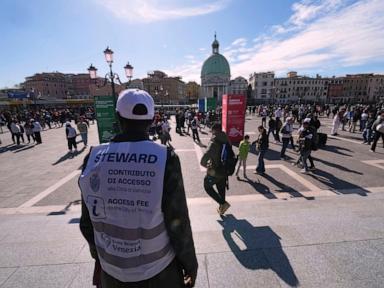Now Reading: Venice expands day-tripper tax in bid to combat overtourism
-
01
Venice expands day-tripper tax in bid to combat overtourism
Venice expands day-tripper tax in bid to combat overtourism

Venice, Italy – Starting Friday, Venice is implementing an arrivals tax for day-trippers to the iconic canal city for the second year, aiming to address the issue of overtourism that endangered the city’s UNESCO World Cultural Heritage status. A UNESCO committee decided not to list Venice as a cultural heritage site in danger following the introduction of the tax. However, critics of the day-tripper fee argue that it has not deterred tourists from visiting Venice, even on busy days.
Here is Venice’s battle with overtourism through some key figures:
– The fee for day-trippers entering Venice’s historic center during the second year of the day-tripper tax. Visitors who obtain a QR code at least three days in advance will pay 5 euros ($5.69), the same amount as last year. Last-minute visitors will pay double. The QR code is required from 8:30 a.m. to 4 p.m. at entry points such as the Santa Lucia train station, Piazzale Roma bus depot, and Tronchetto parking garage.
– The number of days in 2024 that day visitors will be charged to enter Venice’s historic center, including weekends and holidays from April 18 to July 27, an increase from 29 days last year. The updated calendar now includes entire weeks during holidays and extends the fee period to Fridays.
– The revenue generated from the 2024 pilot program for the tax. Venice’s top budget official, Michele Zuin, mentioned that the running costs exceeded the fees collected last year. This year, a surplus of 1 to 1.5 million euros is projected, which will help cover expenses like trash collection and resident services.
– The number of day-trippers who paid the tax in 2024, with over 12,000 visitors paying on the first day. Among the 77,000 registered visitors, 117,000 have exemptions, like Venetian residents, property taxpayers, students, workers in the historic center, or those living in the Veneto region.
– The average daily visitors on the initial 11 days of 2024 when Venice levied the day-tripper fee, showing an increase compared to previous years. Despite this, opponents like city council member Giovanni Andrea Martini believe that the project has not discouraged visitors.
– The current number of residents in Venice’s historic center, which has been declining due to various factors like economic shifts, urbanization, and tourism. With over 12,000 beds available for tourists, the number of tourist accommodations surpasses the number of permanent residents, causing concerns about the city’s demographics and services.
– The annual influx of day-trippers and overnight guests, monitored through cellphone data via a Smart Control Room since 2020, provides insights into the tourism trends in Venice.





